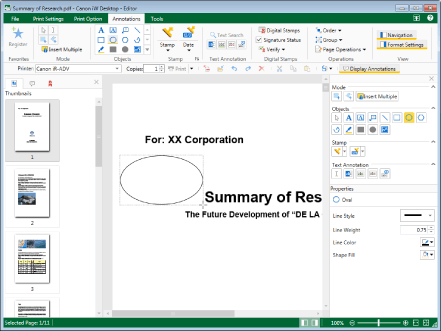Inserting Ovals
With Desktop Editor, you can insert an oval into a document as an annotation.
1.
Click  (Oval) on the ribbon.
(Oval) on the ribbon.
 (Oval) on the ribbon.
(Oval) on the ribbon.Or, click  (Oval) on the Details Window.
(Oval) on the Details Window.

The properties of the oval are displayed on the Details Window.
|
NOTE
|
|
If the Details Window is not displayed, see the following.
This operation can also be performed with the tool buttons on the toolbar. If tool buttons are not displayed on the toolbar of Desktop Editor, see the following to display them.
When you want to insert ovals multiple times, double-click
Perform one of the following operations to cancel the button selection.
Click the selected button on the Details Window again
Click another button on the Details Window
Click a command on the ribbon
Press the [Esc] key on the keyboard.
You can click
 (Insert Multiple) on the ribbon to insert multiple annotations. For more information, see the following. (Insert Multiple) on the ribbon to insert multiple annotations. For more information, see the following. |
2.
Configure the properties of the oval.

|
[Line Style]
|
Select the line style you want to use from the list displayed when you click
|
|
[Line Weight]
|
Set the line thickness. You can specify a line thickness from 0.25 point to 12.00 point. You can specify a line thickness in units of 0.25 point by using
|
|
[Line Color]
|
Select the line color you want to use from the list displayed when you click
|
|
[Shape Fill]
|
Select the color you want to use to fill from the list displayed when you click
|
|
NOTE
|
|
If you select [More Colors] in [Line Color] or [Shape Fill], the [Color] dialog box is displayed and you can set a color that is not listed in [Line Color] or [Shape Fill].
You can also configure the properties of the annotation with the following commands.
 (Line Style) (Line Style) (Line Weight) (Line Weight) (Line Color) (Line Color) (Fill) (Fill)If commands are not displayed on the ribbon of Desktop Editor, see the following to display them.
This operation can also be performed with the tool buttons on the toolbar. If tool buttons are not displayed on the toolbar of Desktop Editor, see the following to display them.
|
3.
Move the mouse pointer to the Work Window.
The shape of the mouse pointer changes to  .
.
|
NOTE
|
|
To cancel the insertion process, do one of the following.
Click
 (Select Object) on the ribbon (Select Object) on the ribbonClick
 (Select Text) on the ribbon (Select Text) on the ribbonClick
 (Grab Mode) on the ribbon (Grab Mode) on the ribbonClick the command selected on the ribbon again
Click
Click
Click
Click the selected button on the Details Window again
Press the [Esc] key on the keyboard
|
4.
Drag the mouse pointer from the starting point to the ending point of the oval.

|
NOTE
|
|
You can insert a circle by dragging the mouse pointer while holding down the [Shift] key on the keyboard.
The starting and ending insertion points of an oval are the corners that face each other in the rectangle that circumscribes the oval. When dragging the mouse pointer from the starting insertion point to the ending point, drag it diagonally to create a rectangle that circumscribes the oval.
|
5.
Click on the Work Window outside the oval you inserted to deselect the oval.